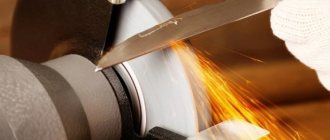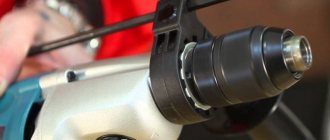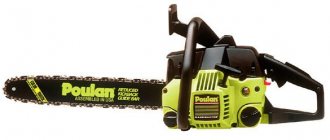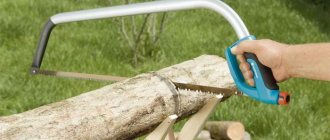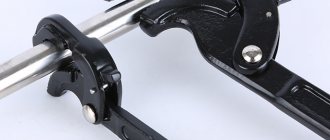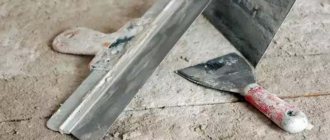Marking the cutting line
Side cutters are also used to apply notches to thin metal parts, marking cutting lines with a hacksaw or jigsaw.
This function of this tool significantly makes the work of a mechanic easier if he needs to make a precise cut, but simple construction scissors do not bite a sheet of metal, but only slide off it.
Professional sharpening of manicure instruments
The most reliable way to sharpen nail scissors or tweezers is to take them to a nail technician. Having once splurged on expensive and high-quality tweezers, do not even try to straighten the cutting edge yourself at home without experience - you will completely ruin it!
The price of the service ranges from 200 - 500 rubles, a good sharpening will last at least six months - a year, if you do not do manicure professionally.
Consider the cost of the tool, possible risks and the cost of sharpening.
Simple operating principle
The design of side cutters is not much different from the design of pliers and wire cutters. The working components of this tool are connected by a special hinge.
A spring is placed between the handles. After the end of the compression period, it returns the handles to their original position. This happens immediately after biting an iron thread or cutting off a plastic edge.
Basic Rules
Experts recommend sharpening scissors once every 6 months. If the instrument begins to “deteriorate” earlier, do not delay this procedure. The main sign that indicates the need for sharpening is the appearance of dark spots. Just keep in mind that before the process itself, the scissors need to be prepared a little.
pexels.com
How do you know if scissors need to be sharpened? There are several ways to help you realize this. Often, for example, a plastic bag, film, wet wipe or even latex gloves are used. These materials are used to conduct tests that evaluate the blades. Fix the material so that it lies flat. Place it between the blades of the scissors and try to cut it. If the material begins to cling to the scissors or tear, then it’s time to process the tool.
Durability and comfort
Thanks to the indestructibility of the hinge joint, the master can press the handles of the side cutters as hard as he likes when processing metal workpieces. The strength of the cutting edges of the tool is ensured by the use of metals of increased hardness for their manufacture.
However, even the most durable side cutters must be very easy to use, which is necessarily taken into account during their manufacture.
Rating of side cutters
This review looked at tools from different categories made by well-known brands. The quality of steel and insulation, as well as the comfort of working in different conditions, were checked. User opinions were studied and reviews from professionals were taken into account. Particular attention was paid to the following characteristics:
- Purpose – they produce models for repairing electronics and laying wiring;
- Design – the presence of a return spring will reduce the applied effort;
- Maximum working stroke - depends on the length of the jaws, affects the scope of application;
- Metal hardness - the higher the indicator, the greater the load the tool can withstand.
Rapid failure of hinges, non-compliance of multilayer insulation with the declared characteristics, raw metal of cutting edges - products with such defects were excluded from our rating.
Modern dielectric cases
For this reason, the handles of side cutters are given ergonomic shapes. At the same time, they are covered with polymer attachments that prevent the hand from fogging in case of prolonged use of the tool. If it is used by the same master for a long time, then the soft handles gradually take on the shape of the owner’s palm.
Modern comfortable polymer materials used for the manufacture of dielectric handle covers do not leave bruises, dents and abrasions on the hands, which can appear with strong compression of old-style hard plastic insulating attachments.
How to sharpen wire cutters with your own hands
Here I will talk about 5 main factors that determine whether you succeed or not.
Today on YouTube there are a huge number of videos on how to sharpen wire cutters. There is a description on various sites that make money from advertising and attracting traffic, and the quality of the information there is of very questionable quality. There is a lot of information on this matter, but it is still not clear how to sharpen it yourself.
I watched a lot of videos and didn’t see a description of the most important thing anywhere.
The very main thing on which it all depends .
What I have seen is that sharpeners often intentionally make this topic very difficult. They create mystery, like: “We sharpen on special machines. “This is our special paste...” “This is our special... something else.” Everything is special and they don’t have anything simple.
But the truth is that the essence of sharpening wire cutters is very simple!
So you want to learn how to sharpen wire cutters yourself at home.
Fine. The question is simple: “Why do you need this?”
That is, if you want to save money, you won’t be able to save money. You will waste time. It's also worth something. Put in the effort. You will need some equipment, expensive or inexpensive, but in any case you will need something.
Therefore, it makes more economic sense to give the wire cutters to someone who already knows how.
Give the wire cutters to a professional for sharpening.
Today, sharpening wire cutters costs about 300 rubles. Personally, our cost has not changed since 2009. For almost nine years. As we sharpened at this price, we continue to sharpen. It's available to anyone.
The only justified, in my opinion, reason why you should sharpen wire cutters at home is that there is not a single sharpening master in your city, region, country or planet.
If this is the case, and you are determined to learn this, then this article and video will allow you to learn the most important things. The basis. The basics.
5 factors that determine whether the nippers will cut or not are the basis of any technology for sharpening nippers .
That is, no matter what method of sharpening you use - whether on diamond wheels, or needle files, or any other abrasive things - they all come down to these five factors.
All methods, all sharpening technologies come down to consistently introducing 5 factors and, thereby, getting the cutters to perform their functions.
What is the purpose of wire cutters?
The answer seems obvious. The purpose of cuticle cutters is to cut the cuticle.
That is, they should cut the cuticle easily and effortlessly, without catching, pinching, biting or wringing. The person presses the handles of the cutters and the cuticle is cut. And this is the purpose of the existence of wire cutters.
What determines whether the nippers will cut or not?
It depends on having 5 factors which you get one after another. One by one. And as soon as they are all installed, the nippers will cut.
If you know WHAT you should get,
If you know WHY you should get it,
If you know HOW you should get it, then a little practice and everything will work out.
Use some kind of sharpening technology and practice.
Source
Lever operating principle
Thick nozzles on the handles guarantee one hundred percent protection against electric shock. Thanks to the application of lever force to the jaws, this tool allows you to cut fairly thick wires and insulated cables.
Usually, to perform a working stroke, the force of one hand is sufficient, but if necessary, the side cutters can be squeezed with both hands, which allows you to cut a wide-section energy line.
The best mini side cutters
Small-sized wire cutters are used when working with radio components, laying network or telephone cables. Short lips make it easier to process small conductors, but at the same time cope well with thin copper wire and stripping cable insulation. When producing side cutters for electronics, special attention is paid to the shape of the handle, which provides comfortable conditions for complex manipulations in conditions of limited usable space.
Rexant 12-4602-1
The model of the Russian company is designed for cutting wires, copper and steel wire of small diameter - up to 1 mm. This is a universal tool that can be used in everyday life and in the professional sphere. The curved shape of the handles makes it convenient to grip with one palm; the bend radius is chosen taking into account effective leverage. Handle covers are made of anti-slip material.
The lips are made of high carbon steel, which is highly durable. The hardness on the surface of the blades reaches 58 HRC, the copper wire does not leave marks on the cutting part, which does not require sharpening. To achieve such values, the working part is hardened. Diagonal sharpening of mini 120 mm side cutters carefully removes the insulating braid from the electrical cable.
Advantages:
- Light weight;
- Oxidized coating, resistant to corrosion;
- Low price;
- Sharp chamfer.
Flaws:
- Not detected.
The convex shape of the handle allows you to fully control the cutting progress. This ensures accurate work with electronic components of devices, household or computer equipment.
Skrab 22532
The Latvian company has developed a model made of tool steel for professional use in the field of microelectronics. Semicircular handles with return springs ensure easy cutting of copper or aluminum wire. The handle covers are made of two-component material that does not slip in the palm. The total length of the tool is 110 mm, making it easy to work in tight spaces.
The sharpening has a diagonal profile, the presence of an antistatic coating on the lips ensures safety when repairing microelectronics. Features of the blade profile make it easy to remove the braid from the wire and cut copper cable with a cross-section of 2.5 sq. mm. There is a loop on the handle for vertical storage.
Advantages:
- Corrosion resistance;
- The blade retains its sharpness for a long time;
- Good handle return mechanism;
- Wear-resistant pads.
Flaws:
- Covers may come off the handles.
Stayer MiniPro 2219-6-12
Made from tool steel, which is characterized by increased strength. The handles are ergonomic, semicircular, and fit comfortably in the palm of your hand. For return, a spring installed in the head is used. The handles are poured, made of polymer, which has anti-slip characteristics.
Hardened sponges are highly durable and resistant to corrosion. An edge with a slight diagonal angle allows you to carefully cut the polymer braid from the wire. Mini side cutters have a length of 125 mm and can be used for repairing electrical equipment in domestic and professional settings. The manufacturer provides a 24-month warranty on its products.
Advantages:
- Flush cut;
- Light weight;
- Minor physical effort;
- Convenient to work in cramped conditions.
Flaws:
- No antistatic surface treatment.
The best splitters
Main Applications
Side cutters are most often used
- Electricians;
- Assemblers of exhibition pavilions, street kiosks, country and park small architectural forms;
- Representatives of housing maintenance organizations, theater decorators, adjusters of communication systems, ventilation, and air conditioning.
Conventional and electrical side cutters
The set of functions for which a particular type of tool is intended is determined by its design features. Standard side cutters are used primarily for cutting plastic, iron, and wires.
Analogues equipped with thick dielectrics are most often used for laying cables in apartments and offices.
Purpose and capabilities of cutters
Nippers are a metalworking cutting tool of the articulated pliers type, designed for cutting wire, nails, rods of various metals and other similar products.
When performing electrical installation, plumbing and various construction works, it often becomes necessary to obtain pieces of wire and cables of different lengths, cut off nail heads, etc. All these works are most simply and quickly performed with a special cutting tool - wire cutters.
Using wire cutters you can perform various operations:
- Working with electrical cables - obtaining sections of the required length, removing excess wires in twists, removing old wires during repairs, etc.;
- Working with metal wire in construction (including when knitting reinforcement), for packaging and securing cargo on vehicles, during unloading operations, etc.;
- Working with fasteners - dismantling and destroying nails or screws, cutting plastic and metal clamps, etc.;
- Performing various auxiliary operations - removing insulation from electrical wires, cutting plastic parts, and others.
Cutting thin and thick wires
The speed and quality of cutting largely depends on the correct use of side cutters. To cut through thin wire or nylon thread, it is enough to place them at the very tips of the blades.
If there is a need to cut through a wide-section wire, then it is placed at the very base of the blades.
Equipment
What are the advantages of sharpening wire cutters using professional equipment:
- high turning speed;
- precision angle adjustment, clear fixation of the position of the sharpening discs relative to the cutting part being sharpened;
- the ability to fully automate work on CNC equipment;
- safety during processing;
- setting the engine speed.
Many machines are equipped with quick-release mechanisms for abrasive discs and manipulators for quickly changing the position of the tool being sharpened. Brand manufacturers include a set of grinding wheels of various grain sizes, allowing for coarse or fine grinding.
Due to the high processing speed and automatic sharpening quality control, increased efficiency is achieved when performing similar tasks. The number of changeable settings is minimal.
Professional equipment is of the following types:
- mechanical, equipped with diamond-coated abrasive discs, due to which the strength of the metal is preserved, the edges are sharpened, and the service life is not significantly reduced;
- laser, allow you to quickly remove metal from the edges, but make it fragile.
The choice of a specific machine depends on the requirements for the quality and speed of sharpening the wire cutters.
Assessing the condition of cutting edges
Any home craftsman or professional installer who is puzzled by how to choose side cutters must first evaluate the quality of the metal from which they are made.
- You should also examine the condition of the blades, especially for nicks, dents, and chips.
- Used tools may well end up in the retail chain, and this fact will be determined by examining the condition of the cutting edges.
Sharpening tools at home
At home, step-by-step sharpening of wire cutters using a file is performed as follows:
- The presence of play is checked; if there is any, it is necessary to seal the connection in a way that depends on its type.
- The surfaces at the joints are cleaned using sandpaper. To do this, it is folded so that it can go into all places. The operation is performed first on one side and then on the other.
- The plane of the cutting edge is sharpened. To do this, place the tool on a flat surface, fix it, and then use smooth movements of the file in the same direction to cut the cutting part from the inside.
- The corners of the blades are sharpening. The cutters are located on the edge of the table and are fixed manually.
- The outer parts of the blades are sharpened.
- The “cheeks” are polished.
- Final edge polishing is carried out along the cutting edges.
- The cutting quality is checked. If it is of poor quality, then all stages of turning are performed again.
- Apply a thin layer of lubricant to the junction of the pliers, and, if necessary, to store the tool, to the entire working part.
The quality of sharpening is checked as follows:
- After processing the edges, the nippers must be securely fastened so that there is no play between the two parts.
- Take thin polyethylene and stretch it in a convenient way.
- Cuts with pliers. The edges should be smooth without burrs or torn parts. The cutting line must be continuous.
Do-it-yourself tool sharpening
Tools
To sharpen tweezers, you will need to prepare the following tools:
- vice;
- diamond-coated needle file;
- core;
- small hammer;
- screwdriver;
- anvil and a flat metal surface;
- 2 pieces of cardboard;
- calipers.
Sharpening level
Checking the sharpening level is carried out as follows:
- The polyethylene sheet is fixed so that the edge is smooth. The cutting edge is placed over the stretched film. An incision is made; there should be no torn or pulled parts.
- The stretch film is fixed in a similar way, then the blades are closed along the entire length. The cut should be smooth, without snags or bends.
- A non-woven cloth allows you to determine the presence of burrs on a metal edge. With high-quality assembly and sharpening of the tweezers, an even cut is obtained.
- Vinyl gloves are pulled between the edges of the tweezers, then pulled down. If the cutting is smooth and there are no pulled edges, sharpening can be considered completed.
Selecting all the tools in advance will allow you to complete all stages of sharpening the tweezers without any problems.
Source
Checking the tightness of the blades
It is also important to check if there is a gap between the edges. The more tightly the blades fit together, the higher the effectiveness of the tool when cutting thin threads and wires. In some cases, professionals use a microscope to assess the tightness of the edges.
It allows you to see not only the gap between the blades, but also the smallest defects on the cutting edges, as well as defects in the protective coating that will become sources of corrosion.
The best universal side cutters
This type of hand tool combines small size and improved technical parameters. The cutters can be used for cutting wires, electrical wiring, and binding wire. Reinforced return mechanisms reduce the load during prolonged operation. Users can buy models with dielectric and chrome plated
Rockforce RF-612175
The pliers of the Belarusian brand are produced at a factory in Taiwan. When creating, high-strength chrome-vanadium steel is used. This increases the service life and makes it easy to cope with thick steel wire and 10-core electrical wires.
The handles are two-component, which makes the grip comfortable and reliable. The surface of the covers is profiled, there is additional protection against slipping. Aggressive design emphasizes the professional class. Diagonal cutting elements ensure an even cut when processing electrical cables. The manufacturer provides a lifetime warranty for this product.
Advantages:
- Convenient shape of the working part;
- Resistant to wear and corrosion;
- Maintains factory sharpening;
- Good control of cutting force.
Flaws:
- Overcharge.
Ingco Hdcp28168
Designed for flush cutting of wire, wire, electrical cable. Length 160 mm allows you to work in conditions of limited usable space. The cutting part is made of chrome vanadium steel, which increases the hardness of the edges and improves corrosion protection. Side recesses make it easier to strip the cable from the braid. Diagonal edge for neat cutting of wires.
The handles are two-component copolymer with good anti-slip characteristics. The surface of the handles is textured, and the finger rests prevent slipping while cutting thick wire. The increased diameter of the cover reduces physical effort. According to user reviews, they have the best balance between price and quality.
Advantages:
- There is no gap between the jaws;
- Handles very thin wire well;
- No jagged edges are formed;
- Soft cases.
Flaws:
- Not detected.
Stanley FatMax 0-89-858
The products of the American brand are manufactured in France; steel with a high content of chromium and vanadium is used in production. The main metal processing technology is forging. This increases strength and service life. The handles are elongated and provide good leverage when biting steel wire. Polished jaws with a diagonal edge for precise work with braided wires.
Handle covers made of two-component polymer material. The material can withstand the aggressive effects of chemicals. The anti-slip coating makes handling cables and wires comfortable. The fit of the cutting edges makes it easy to cut thin wire and paper.
Advantages:
- Durable design;
- Complies with European standards;
- Covers with finger rest;
- Increased edge hardness.
Flaws:
- Sometimes it takes time to develop.
The best oscilloscopes
Main types of side cutters
There are currently two types of this tool on the market:
- Single-hinged;
- Double-hinged.
Selection of the required modification
When purchasing installation tools, the types and sizes of side cutters suitable for a particular craftsman are determined by the frequency and intensity of their future use. To work with a large number of workpieces, it would be better to purchase double-jointed side cutters.
Thanks to the presence of a leaf spring, they instantly return to their original state. At the same time, a double-jointed tool will allow you to spend much less effort on doing useful work.
The best reinforced side cutters
Reinforced side cutters are made only from hardened steel. This increases the hardness of the edges and allows you to cut through steel wire without the appearance of burrs or nicks. The return mechanisms are strengthened, which facilitates long-term work on the construction site. When positioning the hinge, the maximum lever is selected taking into account the overall size.
Kraftool 2202-6-18
The German brand's fitting and assembly tools are manufactured in Taiwan. The model is designed for cutting copper, steel wire, and large-section wires. The production uses chrome vanadium steel, which has good strength and corrosion resistance. Additionally, the working elements are chrome plated to increase service life.
Handles are made of two-component material for a more comfortable grip, the surface is embossed, helping to prevent slipping. The finger stops are clearly defined, durable, and allow for maximum force. The convex shape of the handle makes the lever effective when working with dense materials.
Advantages:
- High-strength cutting edges;
- Antistatic function;
- Good alignment;
- Low price;
- Comfortable handles.
Flaws:
- Not detected.
Gross 17575
The German professional side cutter is made of chrome vanadium steel with additional hardening of the cutting edges by induction current. This made it possible to increase the hardness of the cutting element to 62 HRC. A design feature is the displacement of the hinge closer to the edges; as a result of this decision, the gear ratio of the levers has increased, and the work has become easier for the user.
Additional ribs are provided on the inner surfaces of the hinge to secure the cable. The handles are three-component, made of polymer and rubber. The ergonomic shape of the handle reduces the load on the hand and minimizes the risk of injury. The functionality can be expanded with additional stops for installing a bracket with a suspension or a powerful spring for automatic opening.
Advantages:
- External stiffening ribs to strengthen the structure;
- Anti-corrosion coating based on titanium;
- Manufacturer's warranty 5 years;
- Sharp sharpening.
Flaws:
- Overcharge.
Professional options with dielectrics
While inexpensive standard models are quite suitable for a home craftsman, an electrician will need special dielectric side cutters that can easily withstand electric shocks of up to a thousand volts.
When choosing quality side cutters, the manufacturing company also plays a significant role. A long-known brand that has earned a good reputation among installers is a guarantee of reliability and durability.
If the brand turns out to be little-known or absent altogether, then this fact will give reason to doubt the high quality of the instrument.
Which side cutter is better
The tool is used in different industries; it is difficult to find universal cutters. The VyborExperta.ru team recommends taking into account the scope of application and intensity of use. Taking these parameters into account, we advise you to pay attention to the following brands:
- Rexant - the choice of an electronics technician, a specialist in repairing household appliances;
- Rockforce - for the home workshop;
- Ingco Hdcp28168 – for cutting very thin wire;
- Gross 17575 – the choice of a professional.
All the models presented in the review are worthy of the attention of users, but only the most durable and functional received the title of the best tools in their class.
Famous brands and fly-by-night companies
Naturally, tools of dubious quality will be offered at a much lower cost than side cutters from proven brands
- N.W.S.;
- Knipex;
- Bahco;
- Wiha;
- Kraftool;
- KBT.
However, this does not mean at all that cheap analogues will not break a week or two after purchase. With a high probability, their cutting edges will quickly become covered with deep dents, after which such a tool will be suitable only for chopping nuts.
Photo of side cutters
Share with friends


